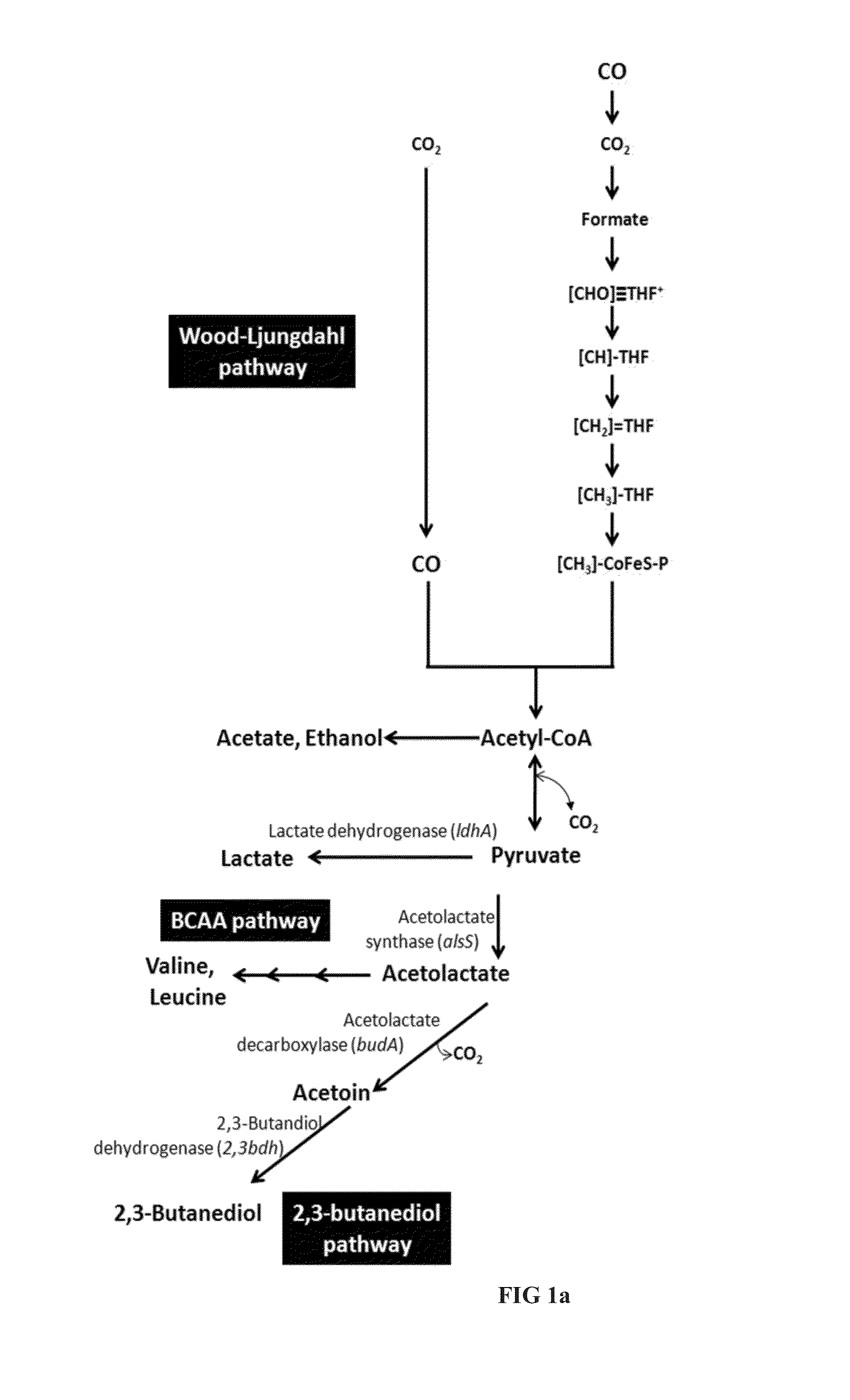Recombinant microorganisms and methods of use thereof
a technology of recombinant microorganisms and methods, applied in the field of chemical compound production methods, can solve the problems of difficult recovery and separation of desired products, production of multiple products at the expense of production efficiency and yield of a product of particular value, and not always desirable for the microorganisms, so as to improve the overall efficiency of alcohol production
- Summary
- Abstract
- Description
- Claims
- Application Information
AI Technical Summary
Benefits of technology
Problems solved by technology
Method used
Image
Examples
example 1
Deletion of C. autoethanogenum budA Gene by Homologous Recombination
[0204]Genetic modifications were carried out using a plasmid containing the 5′ and 3′ homology arms of budA gene of C. autoethanogenum DSM23693 (FIG. 1-2). This plasmid was methylated in vivo using a novel methyltransferase and then transformed into C. autoethanogenum DSM23693 (DSMZ, Germany). The budA gene knockout has been shown by PCR and by the inhibition of 2,3-butanediol production in C. autoethanogenum DSM23693 ΔbudA strains.
Construction of Expression Plasmid:
[0205]Standard Recombinant DNA and molecular cloning techniques were used in this invention and are described by Sambrook et al, 1989 and Ausubel et al, 1987. DNA sequences of 5′ upstream flanking homology arm (Seq. ID 3) and 3′ downstream flanking homology arm (Seq. ID 4) of Clostridium autoethanogenum DSM23693 budA gene were obtained from NCBI.
[0206]Genomic DNA from Clostridium autoethanogenum DSM23693 was isolated using Purelink Genomic DNA mini kit f...
example 2
Succinate Pathway
[0225]The pathway for production of succinate is described in FIG. 1b. Respective genes were identified in Clostridium autoethanogenum and enzyme activity was demonstrated.
[0226]In a first step, pyruvate is converted to malate, either directly catalyzed by a malic enzyme or via oxaloacetate catalyzed by a malate dehydrogenase. Oxaloacetate (OAA) can be produced from pyruvate by action of a Pyruvate carboxylase, or via Phosphoenolpyruvate (PEP) in a two step conversion catalyzed by Pyruvate phosphate dikinase (PPDK) and PEP carboxykinase (PCK). Malate is subsequently converted to succinate in a two-step process catalysed by Fumarate hydratase and fumarate reductase. Respective genes were identified in C. autoethanogenum and homologous genes are present in other carboxydotrophic acetogens as C. ljungdahlii and C. ragsdalei (Table 7).
TABLE 7Genes and Enzymes identified to be involved in Succinate productionMalic enzyme 1Seq. ID 38-39CP001666.1Seq. ID 60-61CLJU_c04160;A...
example 3
Group II Intron Based Insertional Inactivation of Genes Involved in 2,3-BDO Biosynthesis in C. autoethanogenum DSM23693
[0235]Design and Construction of ClosTron Constructs Targeting budA and 2,3Bdh Gene:
[0236]The acetolactate decarboxylase (budA) and 2,3-butanediol dehydrogenase (2,3-bdh) genes involved in 2,3-Butanediol production in C. autoethanogenum DSM23693 were inactivated using ClosTron group II intron mediated gene disruption tool (Heap et al., 2010). The Perutka algorithm hosted at ClosTron.com was used to identify the group II intron target site between bases 450 / 451 and 468 / 469 on the sense strand of budA and 2,3-bdh genes, respectively. The same algorithm was used to design the intron targeting regions (Seq. ID. 82 and 83) which was commercially synthesized by DNA2.0 and delivered in pMTL007C-E5 vector. The final vectors, pMTL007C-E5-budA-450!451s and pMTL007C-E5-2,3bdh-468!469s, contain a Retro-tranposition-Activated ermB Marker (RAM) which confers resistance to antibio...
PUM
| Property | Measurement | Unit |
|---|---|---|
| Fraction | aaaaa | aaaaa |
| Fraction | aaaaa | aaaaa |
| Volume | aaaaa | aaaaa |
Abstract
Description
Claims
Application Information
 Login to View More
Login to View More - R&D
- Intellectual Property
- Life Sciences
- Materials
- Tech Scout
- Unparalleled Data Quality
- Higher Quality Content
- 60% Fewer Hallucinations
Browse by: Latest US Patents, China's latest patents, Technical Efficacy Thesaurus, Application Domain, Technology Topic, Popular Technical Reports.
© 2025 PatSnap. All rights reserved.Legal|Privacy policy|Modern Slavery Act Transparency Statement|Sitemap|About US| Contact US: help@patsnap.com



